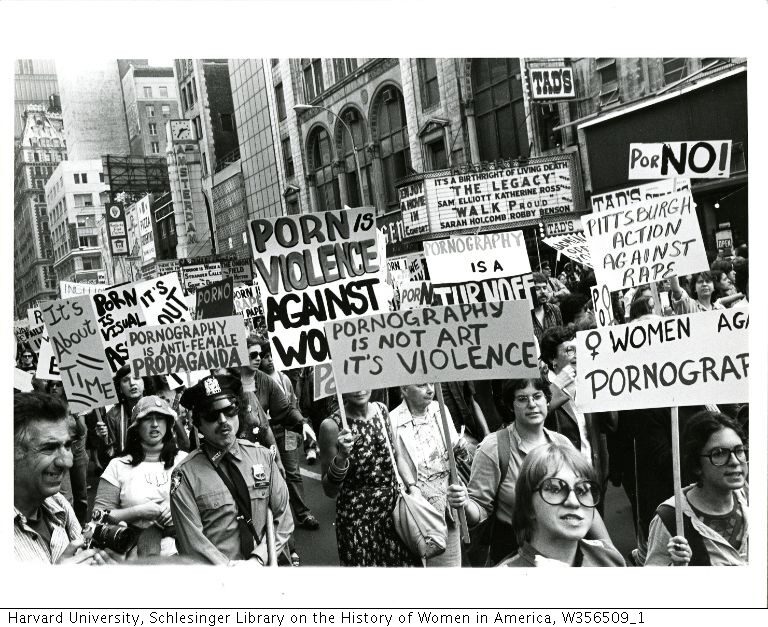In the 1970s in the United States, there was a growing awareness of the amount of violence experienced by women at the hands of men: incest, domestic violence, rape, sexual harassment, and forced prostitution. In response to this growing awareness, many things happened. Amongst them was a campaign against graphic depictions of violence against women in the media, which hitherto had glamorized that violence and made it seem normal—to be expected.
The 1980s witnessed the rise of a group of feminists who focused much more on sexually explicit material. It seemed a plausible theory that you can make something attractive by pairing it with sexually explicit material. As a result, the lawyer and feminist legal theorist Catharine MacKinnon began to develop legislation aimed at making the producers and distributors of material that paired sexual explicitness with violence open to lawsuits for making and distributing that material, if it could be shown to have harmed women. The proposed legislation did not target sexually explicit material in general, and would have worked in a manner similar to sexual harassment legislation.
This legislation was always going to be controversial in the United States, research fellow at the University of Tartu, Institute of Philosophy and Semiotics, Alexander Stewart Davies noted, because sexually explicit material is considered a form of protected speech there. “It is part of what is protected by the First Amendment of the US Constitution. So it was obvious when drafting the legislation that others were going to challenge it on grounds that it violated the First Amendment,” he explained.
Women versus pornographers?
Davies wrote a paper[1] that assesses one of the arguments that were used to support this legislation against the accusation that it restricted protected speech. “In some circles, the argument is now known as “the free speech argument”. It’s called that because the argument aims to show that the legislation actually promotes the free speech of women. Here’s how the argument goes. Women’s freedom of speech is already impinged upon by sexually explicit material that is paired with violence and force by men against women. So if the legislation ends up reducing the production of such material, then it helps block a restraint on women’s speech,” he said and added that in effect, there’s a conflict of two speech liberties: the liberty of pornographers to produce material that pairs sexual explicitness with gendered violence and force, and the liberty of women to speak their minds. Thus the first amendment—a protection of speech liberty—doesn’t determine what to do here.
The claim that sexually explicit material that’s paired with gendered violence or force somehow silences women’s speech is very controversial indeed, Davies affirmed. “I suspect many readers will simply be incredulous—“how could women’s speech be infringed by this kind of material?” they’ll be asking. But I think the claim deserves some merit. Consider rape trials, for example. An awful lot of what happens in those trials hangs upon what a jury or a judge will find plausible about a woman’s consent. Whether she gave it, and how consent is communicated. It has been shown that repeated exposure to sexually explicit material that’s paired with gendered violence or force influences the way in which people interpret sexual scenarios,” he explained and added that, in particular, it can cause people to interpret what they previously thought of as rape, as instead, consensual sex.
Davies also said that if this material can have that effect, then when a rape victim speaks at her trial, she will find it difficult to be understood in the way she intends. Thus such material impedes her speech by the effects it has on her audience—and it does so as she attempts to get justice for a severe wrong that was done to her. “We could also say the same about other occasions in which women who have experienced sexual violence are misunderstood or not believed, such as when they speak to friends and family about this, or when they try to report what happened to them to the police,” he noted.
Extremely controversial topic
Liberal states protect freedom of speech. But Davies doubts there is a single (liberal) country which does not at the same time regulate speech. He adduced laws regulating libel, severely misleading advertising, fighting words, hate speech, incitements to suicide, child pornography and speech owned by others (e.g. trademarks) as examples. “There are good reasons offered in favour of these kinds of regulations—can you imagine what it would be like to live in a society in which none of that was regulated? If it were true that a certain kind of speech rendered instruments of justice (such as the courts and the police) systematically toothless when those instruments attempt to address violence effected by one particular group upon another, then that would seem like a good ground to take seriously the regulation of that kind of speech,” he said.
But exactly how it should be regulated, and what purposes are honestly served by different methods of regulation, are things we need to be very clear about, Davies stressed: “If we are not, then we might end up doing something which has consequences which are the opposite of what were originally intended.”
The existing literature on the free speech argument tended to pitch the interests at stake on this matter as falling into two mutually exclusive sides: women and pornographers, Davies said. “This makes it easier to believe that the proposed legislation simply, and without complication, promoted women’s liberty and didn’t threaten it. But would things really be that simple? Would the legislation in no way also have the opposite effect?” he asked.
Larger conversation in society
The free speech argument has been interpreted as a way of showing how the legislation put forward by MacKinnon could be understood as consistent with the liberal value of liberty. For, according to the argument, the legislation promoted liberty. It defended women’s liberty of speech against a restriction already placed upon it. Davies’ paper showed that this claim is only partly true. In the paper, he describes the many women who produce and have an interest in using material that pairs sexual explicitness with gendered violence and force. “For example, there was a magazine published between 1984 and 2006 called On Our Backs. It included sexually explicit material that was combined with force used against women. But if you look at the letters pages of this magazine, then you can see that the magazine (and its content) improved the lives of many of its readers, for a variety of reasons—which I describe in my paper.” Davies went on to point out that: “These women’s liberty to produce and read On Our Backs would have been hindered by the legislation. So if the legislation was aimed at promoting women’s liberty, it is to some extent a self-defeating piece of legislation.”
The situation is analogous to attempts to promote women’s liberty by banning the wearing of the veil. If bans on the veil are aimed at promoting women’s liberty, they are to some extent self-defeating for the reason that many women want to wear the veil (and they have their reasons for doing so). In both cases—the problematic sexually explicit material and the veil—a presumption is made about the homogeneity of women, a presumption which is false, and whose falsity makes such legislation to some extent self-defeating, Davies explained.
So, the paper is part of the larger conversation about how to regulate speech within a liberal context that values freedom of speech. Davies suggested the key lesson to draw from it is that we should be very careful when producing legislation that is aimed at promoting the liberties of particular groups of people not to build into that legislation assumptions about commonalities between them that don’t exist. “If we don’t recognise that, then we are liable to produce legislation that has consequences that are the opposite of those we intended the legislation to generate. This is now a well-worn concern—particularly since the rise of intersectional feminism in the 1990s,” he said and added that the paper works out that concern in a domain within which it had not previously been registered.
[1]https://www.pdcnet.org/pdc/bvdb.nsf/purchase?openform&fp=soctheorpract&id=soctheorpract_2018_0044_0001_0021_0048
*Photo source: http://catchingthewave.library.harvard.edu/items/show/2745
Written by Marii Kangur
This article was funded by the European Regional Development Fund through Estonian Research Council.
 Back
Back



